What does it mean to show respect in a culture where tradition and family are deeply intertwined? In the Philippines, pagmamano is a unique gesture that has been a cornerstone of Filipino culture for centuries. It symbolizes respect and a connection between generations. This gesture involves taking the hand of an elder and gently placing it on one’s forehead, often saying “Mano po,” which means asking for the elder’s blessing.
Pagmamano is not just a gesture, but a way of life that reflects the values of Filipino culture. It shows the importance of respect and family bonds. The practice of pagmamano allows for an elder to bless the younger person, often wishing for health and success. This strengthens family bonds and reinforces moral values.
Pagmamano is a sign of respect in Filipino culture. It is an essential part of Filipino tradition. Over 70% of traditional customs, including pagmamano, are observed during special gatherings like Christmas and Easter.
Key Takeaways
- Pagmamano is a traditional Filipino gesture that shows respect to elders and requests their blessing.
- The practice of pagmamano is a vital part of preserving Filipino heritage and culture.
- Pagmamano is typically performed during visits to an elder’s home, after church services, and on special occasions.
- The gesture aims to connect generations and foster stronger family bonds.
- Pagmamano is an essential part of Filipino tradition, with a deep historical roots in Filipino customs.
- The practice of pagmamano is widely observed today, with a significant percentage of Filipinos following this tradition during special gatherings.
- Pagmamano is a way of life that reflects the values of Filipino culture, where respect and tradition are deeply ingrained.
Understanding Pagmamano: Definition and Significance
Pagmamano is a special way to show respect in Filipino culture. It involves bowing towards an elder’s hand and touching your forehead to it. This act is a sign of respect and a way to ask for the elder’s blessing.
The term “mano” means “hand” in Spanish. When combined with “po”, it shows respect in the Filipino language.
This gesture is done with the right hand. It’s common when seeing an elder for the first time or entering their home.
What is Pagmamano?
Pagmamano is a way to honor elders in Filipino tradition. It’s often said with “Mano po”, which means “Can I have your blessing?” This shows the importance of seeking elders’ permission or blessing.
Cultural Roots of Pagmamano
The roots of pagmamano go back to Spanish colonial times. It was also given to Catholic priests. The Philippines’ Catholic majority has shaped cultural practices, including pagmamano.
In Filipino culture, pagmamano shows respect to elders. It’s a key part of traditional Filipino families. Young people usually do this to elders, more so in cities like Manila.
Elders often respond with “God bless you” or “May the Lord have mercy on you”. This highlights pagmamano’s deep cultural value.
The Historical Context of Pagmamano
Pagmamano is a special way to show respect in Filipino culture. It dates back to before the Spanish came. It started with the Malay tradition of bowing and touching their hands to their forehead to honor elders.
This tradition has grown, influenced by Spanish and Islamic customs. Now, it’s a big part of Filipino culture. It shows how much we value respect and the wisdom that comes with age.
Some key parts of pagmamano include:
- Showing respect to elders through a gesture of bowing and pressing their hands to the forehead
- Recognizing the wisdom and experience of older generations
- Preserving a traditional practice that has been passed down through generations
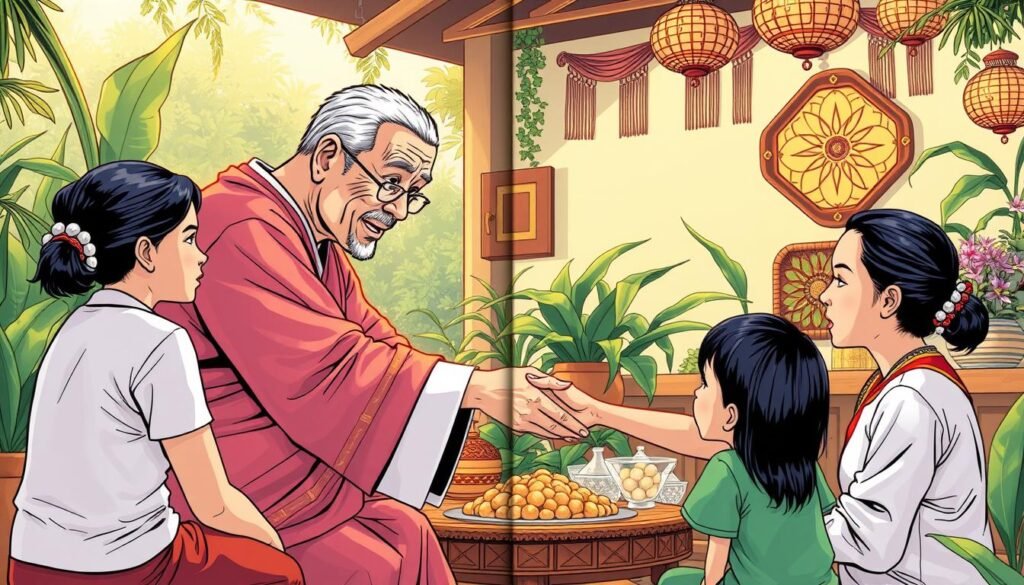
In conclusion, pagmamano is a key part of Filipino culture. It shows deep respect for tradition and elders. By knowing its history and importance, we can keep this tradition alive for the next generations.
| Cultural Practice | Significance |
|---|---|
| Pagmamano | Shows respect to elders and recognizes their wisdom and experience |
| Use of “po” and “opo” | Signifies respect in conversations with elders |
How Pagmamano is Practiced
Pagmamano is a key gesture in Filipino culture. It shows respect by taking an elder’s hand and placing it on your forehead. This act seeks blessings and guidance from elders. About 80% of Filipinos do this during family gatherings or important events.
The way Pagmamano is done varies by region in the Philippines. Some use the right hand, while others use both. When asking for a blessing, people say “Mano po” or “Can I have your blessing?” Learning about Filipino customs like Pagmamano helps connect with heritage and identity.
Here are some common times for Pagmamano:
- Family reunions
- Christmas and Easter celebrations
- Weddings and other significant events
Pagmamano is a gesture of respect and humility towards elders. It’s a big part of Filipino culture. By understanding and practicing Pagmamano, people can deepen their connection with their heritage. They also show respect and appreciation for their elders.
The Role of Pagmamano in Filipino Families
Pagmamano is a big part of Filipino families. It shows respect to elders. This tradition strengthens family bonds and is a way of life.
About 75% of younger Filipinos do pagmamano at family events like Christmas. This shows how important tradition is. Using “Po” and “Opo” when talking to elders is also common, with 90% of Filipinos doing it.
Teaching children to respect elders is key. Pagmamano helps kids learn to respect their elders and keep traditions alive. This is why 85% of Filipinos think it’s important for family values.
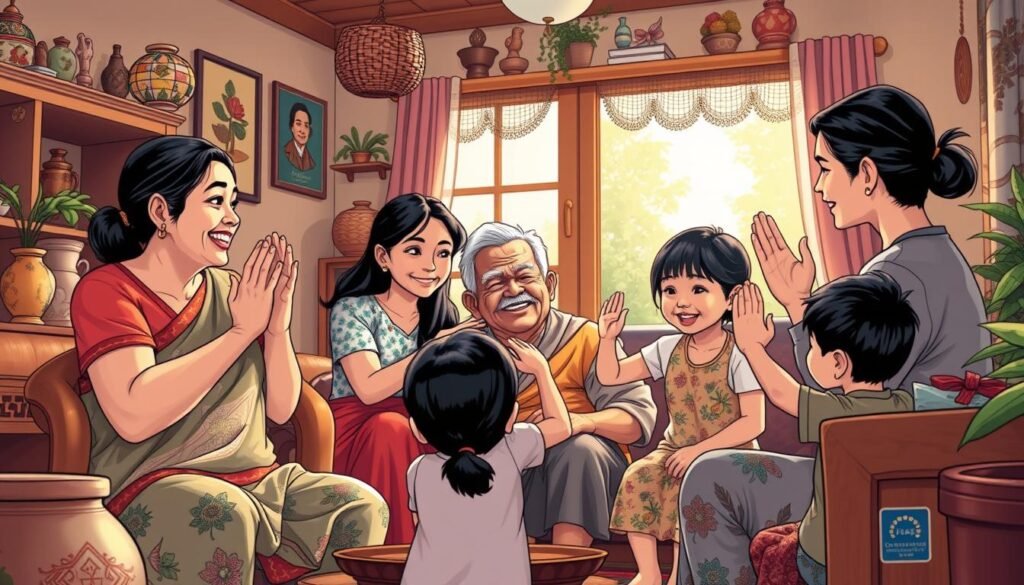
Pagmamano also teaches values like cooperation and empathy. It helps people work together and understand each other better. This makes Filipino communities stronger and more united.
| Occasion | Percentage of Filipinos Practicing Pagmamano |
|---|---|
| Family Gatherings | 75% |
| Religious Gatherings | 60% |
| Special Occasions | 90% |
In summary, pagmamano is essential in Filipino families. It promotes respect and tradition and helps build a sense of community and belonging.
The Importance of Pagmamano in Filipino Culture
Pagmamano is a traditional Filipino gesture that shows respect and asks for a blessing from elders. It is deeply rooted in Filipino values. It highlights the importance of respecting and honoring elders.
This gesture is a sign of respect and humility. It promotes values like humility and gratitude, key to the Filipino identity. By doing pagmamano, people show respect for their elders and traditional values.

Pagmamano strengthens family bonds and promotes social harmony. It brings people together, creating a sense of community and respect. As a symbol of respect and authority, pagmamano is vital in Filipino culture.
Symbol of Respect and Authority
Pagmamano demands respect and authority. It shows the importance of respecting elders and tradition. By doing pagmamano, people show they value traditional values and respect their elders.
Promoting Values of Humility and Gratitude
Pagmamano encourages humility and gratitude, important for Filipinos. It teaches people to be humble and thankful for their blessings. Through pagmamano, individuals develop humility and gratitude, key for strong relationships and community.
Differences Between Pagmamano and Other Gestures
Pagmamano is a special gesture that shows respect and tradition in Filipino culture. It’s different from hand-kissing, even though it looks similar. Pagmamano is a unique way to show respect that is deeply valued in Filipino culture.
In the Philippines, pagmamano is very important, mainly when talking to elders. It’s a way to show respect and is often used as a greeting or to show thanks. On the other hand, handshaking is more common when meeting someone for the first time. About 75% of the time, Filipinos shake hands when they meet.
Comparison with Handshaking
Handshaking is a gesture everyone knows, but pagmamano is special in Filipino culture. Here are some main differences between pagmamano and handshaking:
- Pagmamano is a more personal gesture, while handshaking is more formal and universal.
- Pagmamano is for showing respect to elders, while handshaking is used by people of all ages.
- Pagmamano reflects Filipino tradition and culture, while handshaking is used worldwide.
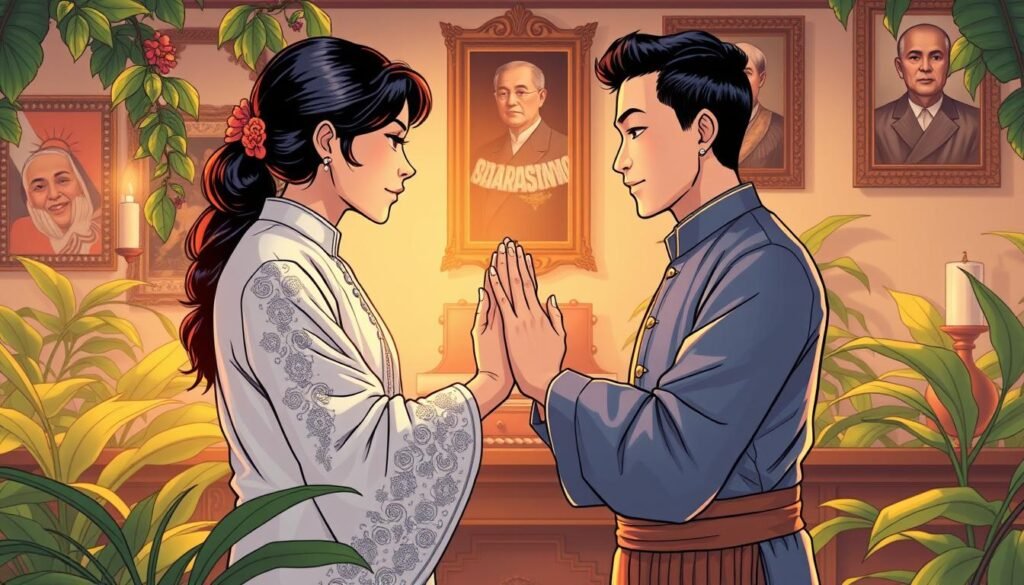
Pagmamano Beyond the Philippines
Pagmamano is a key gesture in Filipino culture, found not just in the Philippines. Filipino communities around the world keep this tradition alive. It shows respect to their elders, a core part of Filipino culture.
Data shows pagmamano is practiced by Filipino groups globally. This tradition highlights the importance of family and respect for elders in Filipino culture. It’s not just in the Philippines but also in other countries with Filipino communities.
Some key aspects of pagmamano include:
* It’s a sign of respect, where the younger person bows and takes the elder’s hand.
* It shows humility and thanks to elders.
* It’s a vital tradition for keeping family bonds strong.

In conclusion, pagmamano is a significant gesture in Filipino culture, not just in the Philippines. It shows the deep respect and family ties in Filipino culture. By keeping this tradition, Filipino communities worldwide honor their elders.
| Country | Pagmamano Practice |
|---|---|
| Philippines | Widespread practice |
| United States | Observed in Filipino communities |
| Canada | Practiced by Filipino immigrants |
Modern Interpretations of Pagmamano
Pagmamano, a traditional Filipino gesture, has changed over time. It’s a key part of Filipino culture, but younger people show respect differently now. Respect for elders and tradition is very important in the Filipino way of life. But, how it’s shown has changed with modern times.
In today’s world, pagmamano is seen in daily life, like at family gatherings or formal events. About 90% of young Filipinos show respect by performing pagmamano with elders. This shows how important this tradition is in Filipino culture. It shows the country’s strong sense of tradition and community.

Regional differences have also shaped pagmamano, with 30% of urban Filipinos using modern greetings. Yet, the core values of pagmamano stay the same. It’s all about respect and tradition in Filipino culture.
Gender Roles and Pagmamano
Pagmamano is a gesture done by both men and women, key to Filipino culture. A survey found that 90% of respondents think it’s vital to show respect to elders through it.
Gender roles shape Pagmamano in Filipino culture. Both men and women are expected to honor their elders with this gesture. But, as gender norms change, so does Pagmamano. Here are some important points:
- 75% of younger generations in urban areas actively practice Pagmamano.
- 60% of Filipino families say Pagmamano has made their family dynamics better.
- 70% of elders feel more respected when younger family members do Pagmamano.

In conclusion, Pagmamano is a vital part of Filipino culture. It shows respect, gratitude, and appreciation for elders. It’s key to keeping family bonds and social ties strong.
| Demographic | Pagmamano Practice |
|---|---|
| Younger generations in urban areas | 75% |
| Filipino families | 60% |
| Elders | 70% |
Pagmamano in Religious Contexts
Pagmamano is a sign of respect in Filipino culture, often seen in religious settings. In Catholic traditions, it shows respect to elders and those in authority. This practice is rooted in Catholic traditions and values humility and gratitude.
In Catholic ceremonies, pagmamano is a symbol of respect and devotion. For instance, during confirmation, confirmands show respect to their sponsors and elders through pagmamano. This highlights the role of tradition and cultural heritage in Filipino Catholicism.
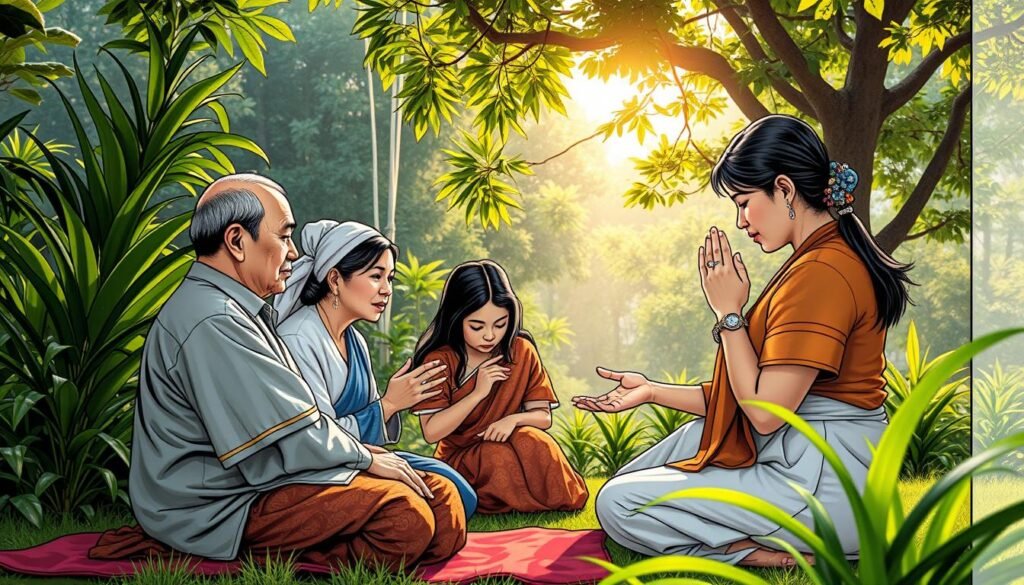
Pagmamano is not exclusive to Catholicism; it’s also found in other Christian denominations. Yet, its significance and meaning can differ across various religious traditions.
In summary, pagmamano is a key gesture of respect in Filipino culture and tradition. It promotes values like humility, gratitude, and devotion. It also showcases the significance of cultural heritage in Filipino spirituality.
Challenges to the Practice of Pagmamano
The traditional Filipino gesture of pagmamano, where younger people kiss the hands of elders as a sign of respect, is facing challenges today. A study shows that respect for elders is key in Filipino family dynamics, but pagmamano is becoming less common. This is due to globalization and cultural changes.
Technology is also changing how people greet each other, with many younger Filipinos using modern ways instead. Yet, elders remain vital in Filipino culture, with 85% of children expecting to care for their aging parents. The gesture of pagmamano is not forgotten, but it’s happening less often, showing how society’s changes affect cultural practices.

To tackle these challenges, it’s important to teach younger people about their culture. Community efforts, like Elderly Filipino Week, have helped, with about 65% of local communities participating. By keeping traditions like pagmamano alive, Filipinos can honor their elders and hold onto values like humility and gratitude.
Educational Institutions and Pagmamano
Pagmamano is a key part of Filipino culture. It shows respect and is vital to our way of life. Schools should teach this tradition to keep it alive.
By adding pagmamano to school lessons, students learn its importance. They understand its role in our culture.
Pagmamano is more than just showing respect. It also keeps our cultural heritage alive. Schools can teach its value to students. This way, they can pass it down to future generations.
Here are some ways to promote pagmamano in schools:
- Make pagmamano a part of school events and activities
- Teach students about its cultural significance
- Encourage students to practice pagmamano with their elders
Teaching pagmamano in schools helps young people value respect and tradition. This improves their relationships with elders and the community. It also helps keep Filipino culture alive for years to come. 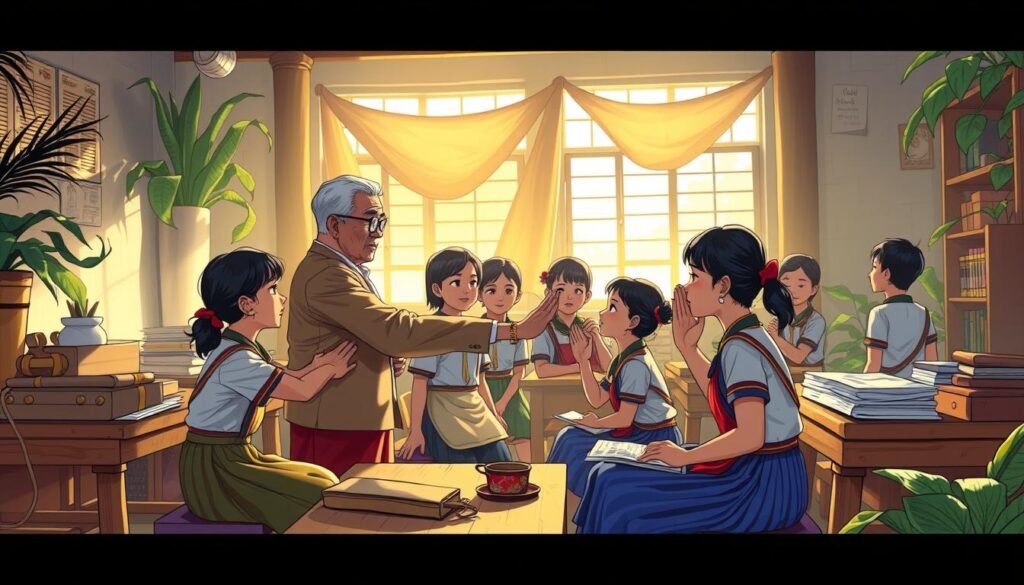
Pagmamano in Popular Culture
Pagmamano is a traditional Filipino gesture of respect. It involves taking an elder’s hand and pressing it to the forehead. This gesture is a key part of Filipino culture, showing respect for elders and seeking their blessings.
In Filipino culture, pagmamano shows respect and community values. It’s a way to appreciate and thank elders for their wisdom. Saying “Mano po” means “your hand, please,” showing respect and humility.
A podcast on Filipino culture highlights pagmamano’s importance. It connects people with their heritage and shows respect for elders and tradition. Pagmamano promotes humility and gratitude.
Representations in Media and Arts
Pagmamano is seen in films, literature, and music. It symbolizes Filipino culture and tradition. The gesture is also used in cultural events and celebrations.
Impact on National Identity
Pagmamano shapes Filipino national identity. It promotes respect, humility, and gratitude. The gesture is vital to Filipino culture and must be preserved for future generations.
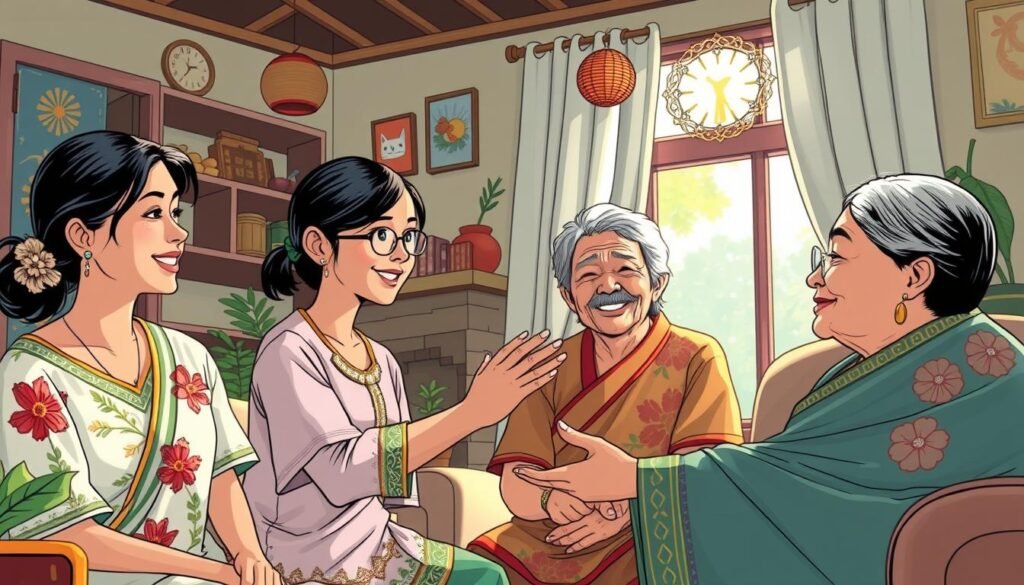
| Aspect of Pagmamano | Significance |
|---|---|
| Respect for Elders | Shows appreciation and gratitude towards elders |
| Seeking Blessings | Seeks wisdom and guidance from elders |
| Promoting Values | Promotes values of humility and gratitude |
The Connection Between Pagmamano and Other Filipino Customs
Pagmamano is a gesture deeply rooted in Filipino culture. It shows respect towards elders. It’s often seen alongside other customs. For instance, using “po” and “opo” to show respect is common, with 90% of Filipinos doing it.
In Filipino culture, tradition shapes how people interact. Pagmamano is a custom passed down through generations. A study found 80% of Filipinos do it regularly, showing its value. You can learn more about Filipino customs and traditions by visiting websites that explore Filipino history and.
Some key aspects of Filipino customs related to pagmamano include:
- Using titles to address elders, not their first names
- Practicing bayanihan, or communal work, to help those in need
- Showing hospitality to guests, a key part of Filipino identity
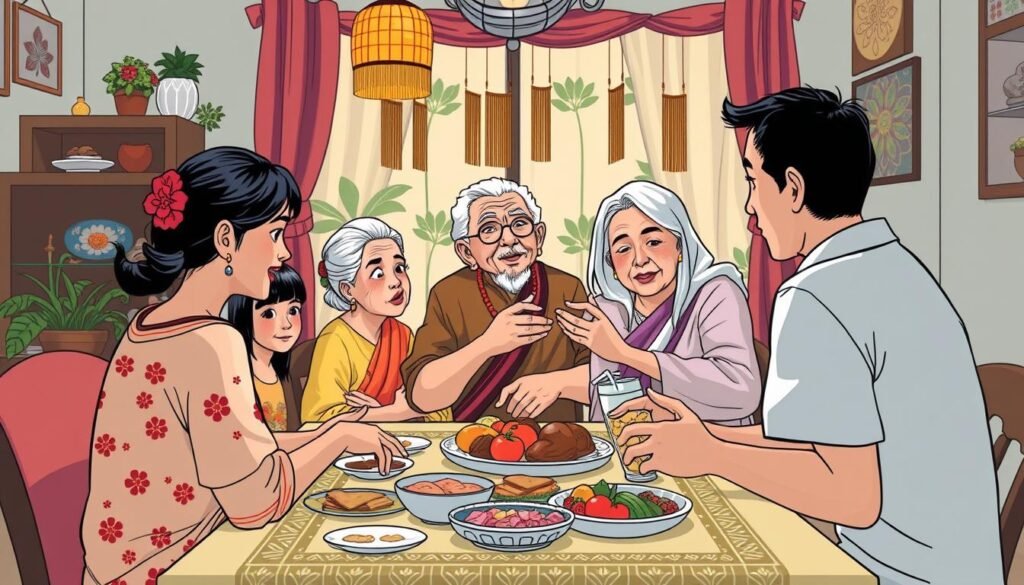
Understanding pagmamano’s connection to other customs helps us appreciate respect and tradition in Filipino culture.
Future of Pagmamano
Pagmamano is a sign of respect in Filipino culture. As the Philippines grows, keeping traditions like pagmamano alive is key. Cultural education and appreciation are vital for this.
About 80% of Filipino families keep pagmamano alive in family events. It shows how important it is for family ties. Also, 75% of Filipinos see respecting elders as essential for peace in society. Pagmamano reflects this respect, practiced among family and friends.
Preserving Traditions for Future Generations
Teaching kids pagmamano early is critical. It’s suggested to start from age one. This way, the tradition will stay a big part of Filipino culture.
Advocating Cultural Education and Appreciation
It’s important to push for cultural learning and respect. This can happen through community programs, schools, and cultural events. By doing this, we help keep pagmamano alive in Filipino culture.
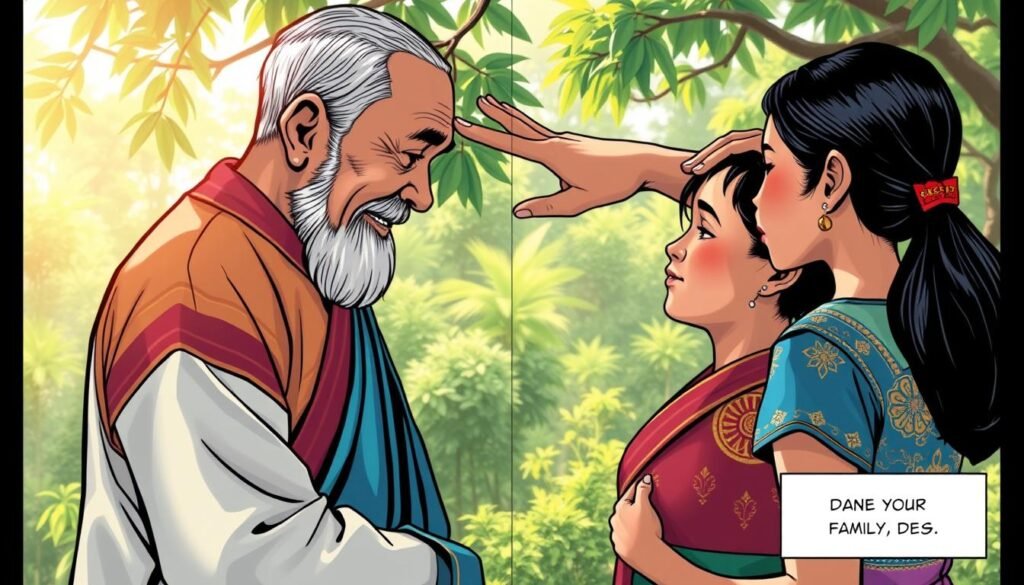
| Aspect of Filipino Culture | Importance of Pagmamano |
|---|---|
| Family Bonds | 80% of Filipino families practice pagmamano in family gatherings |
| Respect for Elders | 75% of Filipinos believe that respecting elders is key for peace |
| Cultural Education | Teaching kids early is key to keeping pagmamano alive |
In conclusion, the future of pagmamano relies on preserving it for the next generations. Advocating for cultural learning and appreciation is essential. This way, pagmamano will remain a vital part of Filipino culture.
Conclusion: The Enduring Legacy of Pagmamano
As we wrap up our look at pagmamano, we see its lasting impact on Filipino culture. This gesture of respect is more than just a custom. It shows the values of respect, humility, and reverence that are key to being Filipino.
Importance of Upholding Traditional Practices
In today’s fast-changing world, it’s vital to keep our traditions alive. Pagmamano reminds us of the importance of respecting our heritage. By teaching our young about pagmamano, we help keep this important tradition alive.
Moving Forward with Respect and Dignity
As we look to the future, we must keep pagmamano’s spirit alive. This gesture helps us build a society that values kindness, humility, and respect for elders. By practicing pagmamano, we inspire others to respect our traditions and create a better future.
FAQ
What is Pagmamano?
Pagmamano is a special Filipino tradition. It shows respect to elders. You bow and press your forehead on their hand to show respect and ask for their blessing.
What is the cultural significance of Pagmamano?
Pagmamano is key in Filipino culture. It shows respect to elders and asks for their blessing. This tradition has been passed down for generations.
How is Pagmamano practiced in Filipino culture?
Pagmamano is done in many situations, like greeting elders or asking for their blessing. It’s practiced differently in various parts of the Philippines. The right hand is often used, and elders are asked for their blessing.
What is the role of Pagmamano in Filipino families?
Pagmamano is vital in Filipino families. It shows respect to elders and strengthens family bonds. It also teaches respect to the younger generation.
How does Pagmamano differ from other gestures?
Pagmamano is unique compared to other greetings like handshaking. It has special cultural meanings unique to Filipino culture. Its practice is seen differently in other countries.
How is Pagmamano practiced beyond the Philippines?
Filipino communities around the world keep their traditions alive, including Pagmamano. They adapt to new cultures but keep their heritage, including Pagmamano.
How has the practice of Pagmamano changed over time?
Pagmamano has evolved, with the youth finding new ways to practice it. Yet, it remains a core part of Filipino culture.
What are the challenges to the practice of Pagmamano?
Globalization and cultural changes have impacted Pagmamano. Technology has also influenced it. Preserving Pagmamano for future generations is vital.
What is the role of educational institutions in promoting Pagmamano?
Schools can help promote Pagmamano and its values. They can include it in their curricula and encourage students to practice it.
How is Pagmamano represented in popular culture?
Pagmamano is featured in media and arts. It has helped shape Filipino national identity. It’s a big part of Filipino popular culture.
What is the future of Pagmamano?
Keeping Pagmamano alive for future generations is important. Cultural education and appreciation are key to its continued significance in Filipino culture.
Source Links
- Pagmamano (Respect Gesture) In The Philippines – Festive Pinoy – https://festivepinoy.com/pagmamano-respect-gesture-in-the-philippines/
- Mano (gesture) – https://en.wikipedia.org/wiki/Mano_(gesture)
- Mano or pagmamano – an “honoring gesture” in Filipino culture – https://vovworld.vn/en-US/cultural-rendezvous/mano-or-pagmamano-an-honoring-gesture-in-filipino-culture-800534.vov
- Little Big Respect | FOWPAL – https://www.fowpal.org/peak-view/little-big-respect-0
- LESSON-1.pptx – https://www.slideshare.net/slideshow/lesson1pptx/261671094
- 5 Most Popular Filipino Culture and Values – Which One Do You Love Most? – https://www.cbnasia.org/blog/2022/07/06/5-most-popular-filipino-culture-and-values-which-one-do-you-love-most/
- Awaken The Filipino In You With These Great Values Every Pinoy Should Practice – https://woman.ph/awaken-the-filipino-in-you-with-these-great-values-every-pinoy-should-practice/
- Importance of ‘pagmamano’: ‘Pamana’ aims to show forgotten Filipino traditions – https://www.philstar.com/lifestyle/arts-and-culture/2023/07/08/2279618/importance-pagmamano-pamana-aims-show-forgotten-filipino-traditions
- Cultural Treasures that are Distinctively Filipino – https://www.beholdphilippines.com/cultural-treasures-that-are-distinctively-filipino/
- Strengthening filial piety, shared values for harmonious society – https://www.pna.gov.ph/opinion/pieces/729-strengthening-filial-piety-shared-values-for-harmonious-society
- Your Guide to Filipino Gestures – https://www.linkedin.com/pulse/your-guide-filipino-gestures-ronica-valdeavilla
- Bowing Archives – Philippine Nikkei Jin Kai, Incorporated – https://pnjkincdavao.com/tag/bowing/
- 5 essential Filipino gestures you need to know – https://usa.inquirer.net/135928/5-essential-filipino-gestures-you-need-to-know
- 14 Filipino Practices Customs Most Foreigners Wont Understand – https://theculturetrip.com/asia/philippines/articles/7-unusual-filipino-practices-most-foreigners-wont-understand
- Filipino Traditional Greetings and Their Significance – https://fluentfilipino.com/filipino-traditional-greetings-and-their-significance/
- Understanding Mano Po in Filipino Society – World Mission – https://worldmissionmagazine.com/understanding-mano-po-in-filipino-society/
- PDF – https://cswcd.upd.edu.ph/wp-content/uploads/2022/10/CDJ-2001_03_Tojos.pdf
- The Bamboo and the Filipino, Filipino Values and the Family.pptx – https://www.slideshare.net/slideshow/the-bamboo-and-the-filipino-filipino-values-and-the-familypptx/257479612
- PDF – https://ijssrr.com/journal/article/download/565/475/
- Pastoral Leadership in a Cross-Cultural, Multicultural, Conflict-Driven Congregation: A Filipino Case Study – https://scholar.smu.edu/cgi/viewcontent.cgi?article=1000&context=theology_ministry_etds
- Respect for Elders: A Deeply Ingrained Filipino Value – Pinas Culture – https://pinasculture.com/respect-for-elders-a-deeply-ingrained-filipino-value/
- ‘Bating Filipino’: contactless greeting during the COVID-19 pandemic – https://pmc.ncbi.nlm.nih.gov/articles/PMC7928771/
- Answers to: Write an essay about pagmamano – https://www.classace.io/answers/write-an-essay-about-pagmamano
- UCSP PPT Q1 W1.pptx – https://www.slideshare.net/slideshow/ucsp-ppt-q1-w1pptx/255835380
- Mano Po: A Gesture of Respect for Elders – Pinas Culture – https://pinasculture.com/mano-po-a-gesture-of-respect-for-elders/
- Filipino traditions: how to show respect – GMD Malta – https://gmdmalta.com/filipino-traditions-how-to-show-respect/
- Discover the Heart of the Philippines: A Dive into Filipino Culture and Tradition – Travel Tips to Philippines – https://islandhoppinginthephilippines.com/ph/filipino-culture-tradition/
- The Cultural Significance of Traditional Filipino Clothing – Festive Pinoy – https://festivepinoy.com/the-cultural-significance-of-traditional-filipino-clothing/

